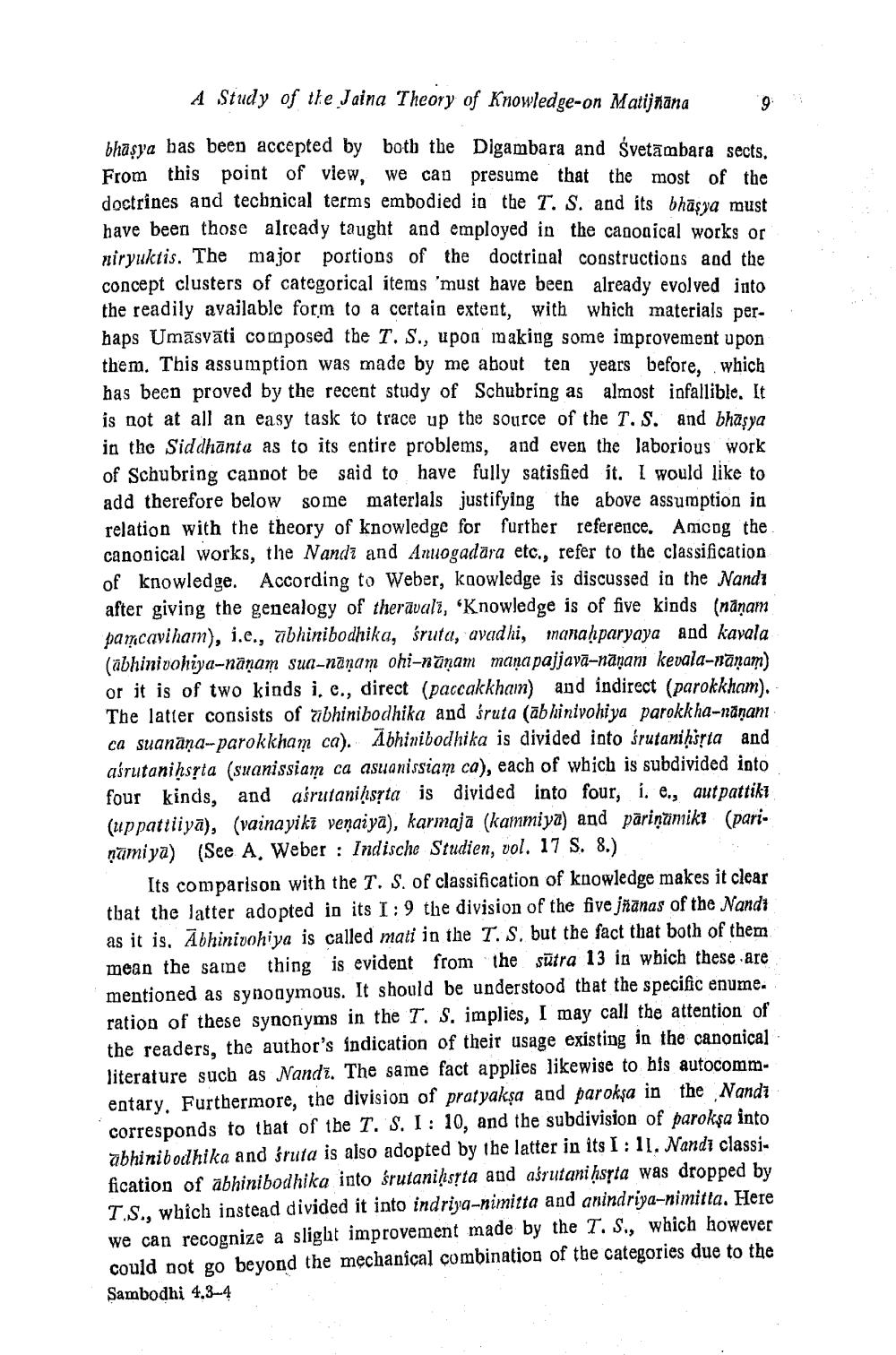________________
A Study of the Jaina Theory of Knowledge-on Matijñāna
bhasva bas been accepted by both the Digambara and Svetāmbara sects. From this point of view, we can presume that the most of the doctrines and technical terms embodied in the T. S. and its bhäsya must have been those already taught and employed in the canonical works or niryuktis. The major portions of the doctrinal constructions and the concept clusters of categorical items 'must have been already evolved into the readily available form to a certain extent, with which materials perhaps Umāsvāti composed the T.S., upon making some improvement upon them. This assumption was made by me about ten years before, which has been proved by the recent study of Schubring as almost infallible. It is not at all an easy task to trace up the source of the T.S. and bhasya in the Siddhānta as to its entire problems, and even the laborious work of Schubring cannot be said to have fully satisfied it. I would like to add therefore below some materlals justifying the above assumption in relation with the theory of knowledge for further reference. Among the canonical works, the Nandi and Anuogadāra etc., refer to the classification of knowledge. According to Weber, kaowledge is discussed in the Nane after giving the genealogy of therāvali, “Knowledge is of five kinds (nāņam pamcaviham), i.e., abhinibodhika, śruta, avadhi, manaḥparyaya and kavala (ābhinivohiya-nanam sua-nanam ohi-nunam mana pajjavā-nanam kevala-nānam) or it is of two kinds i. c., direct (paccakkham) and indirect (parokkham). The latter consists of abhinibodhika and śruta (abhinivohiya parokk ha-nanan ca suanana-parokkham ca). Abhinibodhika is divided into śrutanihsrta and aśrutanihsrta (suanissiam ca asuanissiam ca), each of which is subdivided into four kinds, and aśrutanihsyta is divided into four, i. e., aut pattiki (uppattiiyā), (vaina yiki venaiya), karmaja (kammiya) and pāriņāmiki (parinamiya) (See A. Weber : Indische Studien, vol. 17 S. 8.)
Its comparison with the T. S. of classification of knowledge makes it clear that the latter adopted in its I: 9 the division of the five jñānas of the Nandı as it is. Ābhinivohiya is called mati in the T. S. but the fact that both of them mean the same thing is evident from the sūtra 13 in which these are mentioned as synonymous. It should be understood that the specific enume. ration of these synonyms in the T. S. implies, I may call the attention of the readers, the author's indication of their usage existing in the canonical literature such as Nandi. The same fact applies likewise to his autocommentary. Furthermore, the division of pratyakşa and paroksa in the Nandi corresponds to that of the T. S. I: 10, and the subdivision of paroksa into abhinibodhika and śruta is also adopted by the latter in its I:11. Nandi classification of abhinibodhika into śrutaniksrta and aśrutani hsyta was dropped by T.S., which instead divided it into indriya-nimitta and anindriya-nimitta. Here we can recognize a slight improvement made by the T.S., which however could not go beyond the mechanical combination of the categories due to the Sambodhi 4.3_4




